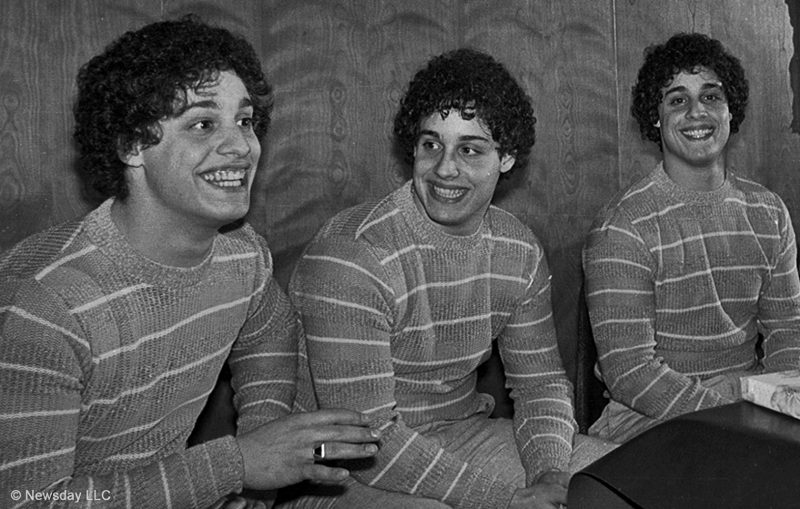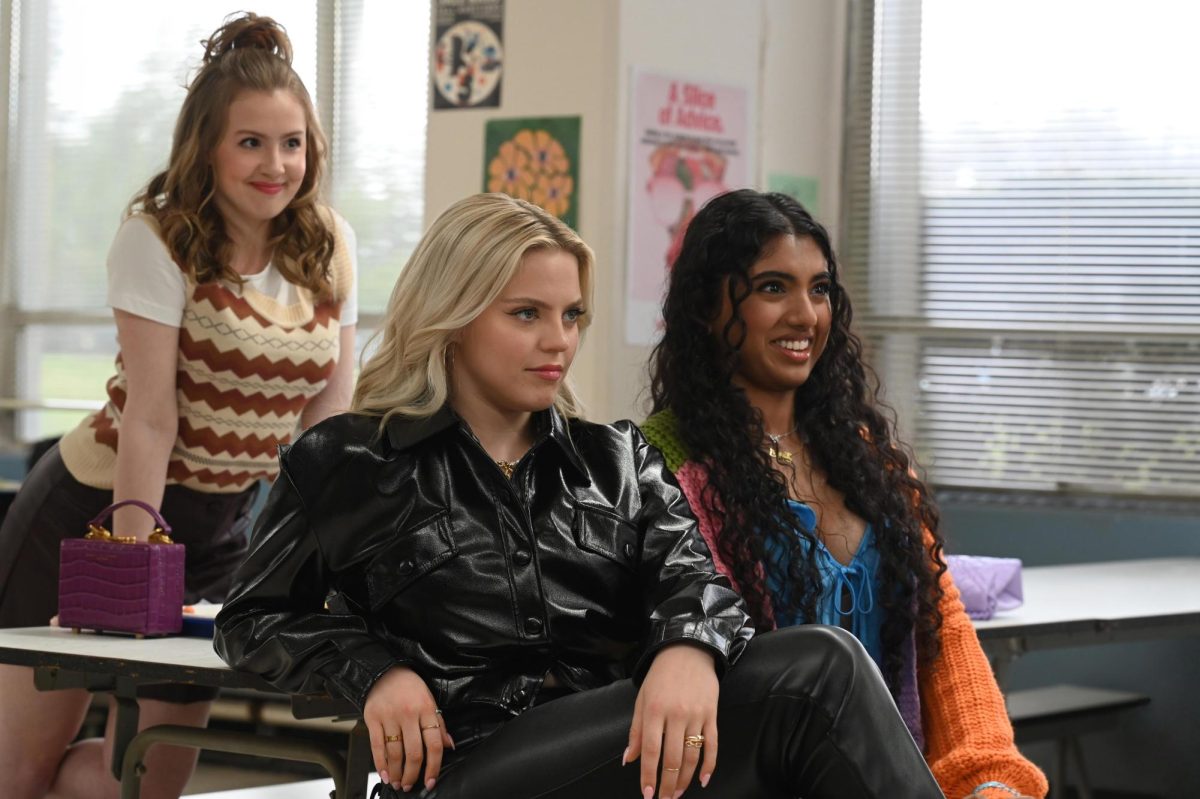Starting as a light-hearted retelling of a impossibly amazing coincidence, “Three Identical Strangers” soon turns into an intriguing investigation that digs into the darker realities of adopted triplets rediscovering each other at the age of 19.
Right off the bat, the audience is thrown into Bobby Shafran energetically describing the day he found out he had a identical brother, Eddy Galland. The viewpoint shifts back and forth from Bobby today to a bright reenactment, which immediately catches the audience’s attention. Later on, David Kellman, the third triplet, joins his sibling to describe the second reunion in which he recognized himself in the newspaper and called the other brothers’ families. Though perhaps this story of long-lost triplets could stand alone, that story was only the beginning in this rabbit’s hole of a film.
With impeccable research and a drive to leave no stone unturned, director Tim Wardle and his team certainly justified bringing a decades-old drama back into the 21st century. The audience could clearly that time to explore every facet of the tale.The emotional and social implications of the triplets’ separation brought the audience to the fundamental human side of the story, while the exploration into the scientific and legal aspects helped immensely to provide broader context as well as a logical backbone to the narrative.
Some media pieces of the triplets during the media craze soon after their rediscovery were shown a few times too many. It was distracting to see a photo/clip for the third or fourth time when it didn’t especially relate or add to that particular part of the film. Additionally there was an absence of a certain someone which wasn’t addressed until late into the documentary, which was off-putting. Other than that, the mostly chronological telling worked well for “Three Identical Strangers” as it felt as if the audience was going through the same experience as the brothers, only 38 years later.
In conclusion. “The Three Strangers” is a documentary well worth a watch. From the charisma of Bobby and David to the journalistic vibes as the plot thickened, this multi-layered story isn’t one to sleep on.
Q&A with director Tim Wardle and producer Becky Read
(Warning! Could contain spoilers)
Q: How did you get involved and why?
A: TW- I was working in development for the company Raw that made this and also made “Imposter” and “American Animals.” So I see loads of ideas coming up like that that come across my desk everyday but the minute this one came across I was like ‘This is the single best documentary idea I’ve ever seen.’ It works on so many levels. It’s an amazing human story, there’s much bigger themes about free will, family, destiny. I was like this has to be made. The fascinating thing about it is ‘Why hasn’t this been done before?’The truth is people have tried to make it before, there being at least three attempts before, one being a major, major US network to make the story. In some cases it got a long way down the line, two in the 80s, one in the 90s. The one in the 90s, and when we spoke to the journalist who worked on it, a triplet pulitzer prize-winning journalist, a big-hitter investigative journalist, got the film, similar to what we’re trying to do. [The journalist] got it all ready to go and at the last minute it was pulled by the network and he has never been given a reason why that happened. So there are huge conspiracy theories about the influence the agency and people like that were able to bring on media organizations. We were paranoid the whole time we were making this film that access was going to be pulled and we were going to get shut down.
[divider style=”dashed” divider_color=”#000705″ size=”2″]
Q: What [the fact that there were other films] a challenge when working with the brothers?
A: BR- I think so which is why it felt satisfying to get it done. But we were nervous making it, wondering . . . knowing that there were a lot of connections between people who worked at the adoption agency and the Jewish board, there’s this triangle. We literally had a huge map venn diagrams of who people were. [We] worried if contacting this person would cause a domino effect of ‘This is happening again. Don’t talk to these people.’ So we were paranoid about doing that. It was really great with David and Robert to make it.
TW- As Becky says, we showed them the film and they loved the film, but more than that it was a sense that we delivered on what we promised and set out to do. That was the most emotional bit about it. They were so pleased that some people who promised them something actually delivered.
[divider style=”dashed” divider_color=”#000705″ size=”2″]
Q: Did you follow their biological mother’s mental records?
A: TW- No, we weren’t able to get access to her biological records. Obviously she passed away but enough people alluded to and actually told us outright about how she was, we felt confident that this was accurate. At Sundance, someone who actually knows the family of the biological mother, came along, watched it on their behalf and said in the end that was a fair portrait of her.
[divider style=”dashed” divider_color=”#000705″ size=”2″]
Q: Are there any other sets of siblings we didn’t get to see?
A: BR- Yes, there are two. There’s a set of male twins who we met and spoke to. There’s a set of female twins who we don’t know where they are. We thought about involving others but it felt like David, Robert and Eddy’s story was so strong that you ending up moving away from your investment in what they’ve been through. We tried to keep it as focused on them as possible, so yes there are at least two other sets who found out much later after David and Robert.
TW- One of the fascinating things is that a lot of the people who found each other who were split up, their relationships were initially very good when they got back together. Then they’ve fallen out with each other since or they’re very fractured relationships and that is across the board. It’s really interesting, that the families talked about there, that when you haven’t grown up alongside someone and developed that kind of familial bond, it’s quite hard to suddenly be thrown into it much later in life. We found it really interesting that happened across the board. People had had these bonds for years and then life and the relationships would be difficult after that.
[divider style=”dashed” divider_color=”#000705″ size=”2″]
Q: Why did you include the set of female twins?
A: BR- I think they had done some research about their own family. They had suspicions about the study being linked to mental illness, and whether that was heritable and whether that link was what researchers were looking for. That was something that had come up quite a few times for very different people across the different areas. So it was part of the story we were interested in and they really served to tell that. They’d written to Louise Wise and gotten that letter about their birth mother having schizophrenia.
[divider style=”dashed” divider_color=”#000705″ size=”2″]
Q: Did you consider the fact that there’s probably a correlation between mental illness and mothers adopting out their children?
A: TW- Yeah, that wasn’t something I’d thought about before making this film, but several people have told us that mental health is a big factor in children being given up for adoption. It’s undeniable. I think adoption is a wonderful thing, I’ve had lots of close friends who have adopted. I think it’s brilliant. It did make me think about adoption in a different way, circumstances in which children are put up for adoption.
BR- When the adoption agency closed, the records were taken over by another adoption agency in New York. When we spoke to someone there after they took over the records, they found it very strange that there was an extremely high number of birth mothers who had mental health problems, far more than any other adoption agencies they had work at and they moved in between. That was slightly . . . They seemed to source a lot of children from mental health institutions. It isn’t a strange thing, it’s common. That’s what happens if you can’ look after a baby but they noticed. [The agency] kept the mental illness of the parents from the adopted parents and there were several lawsuits that happened during that era for wrongful adoption which hadn’t really been done before, hadn’t been challenged in the courts before. They were by families who later found out their children had very serious mental illnesses and the adoption agency withheld that information.





















































































